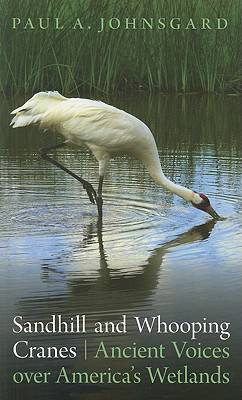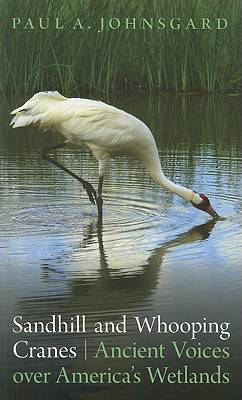
- Afhalen na 1 uur in een winkel met voorraad
- Gratis thuislevering in België vanaf € 30
- Ruim aanbod met 7 miljoen producten
- Afhalen na 1 uur in een winkel met voorraad
- Gratis thuislevering in België vanaf € 30
- Ruim aanbod met 7 miljoen producten
Zoeken
Sandhill and Whooping Cranes
Ancient Voices Over America's Wetlands
Paul A Johnsgard
Paperback | Engels
€ 20,95
+ 41 punten
Omschrijving
Driving west from Lincoln to Grand Island, Nebraska, Paul A. Johnsgard remarks, is like driving backward in time. "I suspect," he says, "that the migrating cranes of a pre-ice age period some ten million years ago would fully understand every nuance of the crane conversation going on today along the Platte."
Johnsgard has spent nearly a half century observing cranes, from a yearly foray to Nebraska's Platte River valley to see the spring migration, to pilgrimages to the birds' wintering grounds in Arizona and nesting territory in Alaska. In this book he draws from his own extensive experience as well as the latest science to offer a richly detailed and deeply felt account of the ecology of sandhill and whooping cranes and the wetlands in which they live.
Incorporating current information on changing migration patterns, population trends, and breeding ranges, Johnsgard explains the life cycle of the crane, as well as the significance of these species to our natural world. He also writes frankly of the uncertain future of these majestic birds, as cranes and their habitats face the effects of climate change and increasing human population pressures. Illustrated with the author's own ink drawings and containing a detailed guide to crane-viewing sites in the United States and Canada, this book is at once an invaluable reference and an eloquent testimony to how much these birds truly mean.
Johnsgard has spent nearly a half century observing cranes, from a yearly foray to Nebraska's Platte River valley to see the spring migration, to pilgrimages to the birds' wintering grounds in Arizona and nesting territory in Alaska. In this book he draws from his own extensive experience as well as the latest science to offer a richly detailed and deeply felt account of the ecology of sandhill and whooping cranes and the wetlands in which they live.
Incorporating current information on changing migration patterns, population trends, and breeding ranges, Johnsgard explains the life cycle of the crane, as well as the significance of these species to our natural world. He also writes frankly of the uncertain future of these majestic birds, as cranes and their habitats face the effects of climate change and increasing human population pressures. Illustrated with the author's own ink drawings and containing a detailed guide to crane-viewing sites in the United States and Canada, this book is at once an invaluable reference and an eloquent testimony to how much these birds truly mean.
Specificaties
Betrokkenen
- Auteur(s):
- Uitgeverij:
Inhoud
- Aantal bladzijden:
- 184
- Taal:
- Engels
Eigenschappen
- Productcode (EAN):
- 9780803234963
- Verschijningsdatum:
- 1/03/2011
- Uitvoering:
- Paperback
- Formaat:
- Trade paperback (VS)
- Afmetingen:
- 141 mm x 228 mm
- Gewicht:
- 240 g

Alleen bij Standaard Boekhandel
+ 41 punten op je klantenkaart van Standaard Boekhandel
Beoordelingen
We publiceren alleen reviews die voldoen aan de voorwaarden voor reviews. Bekijk onze voorwaarden voor reviews.











